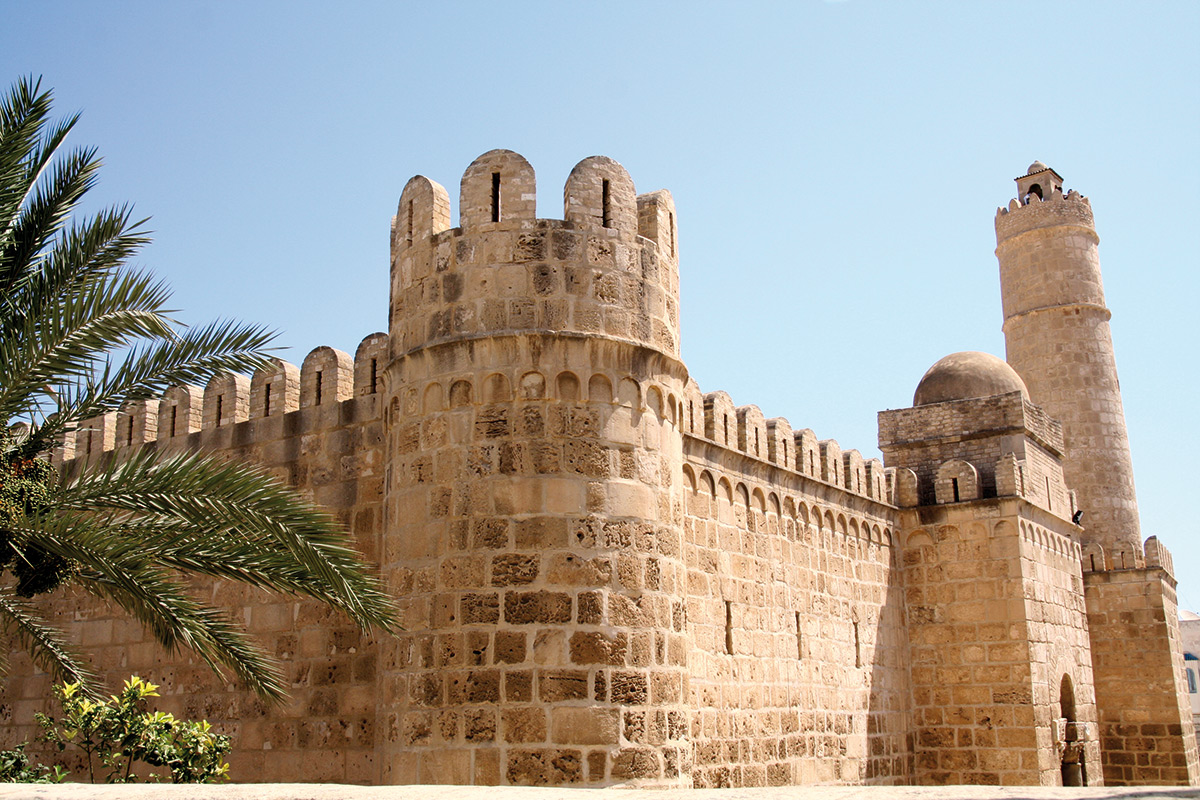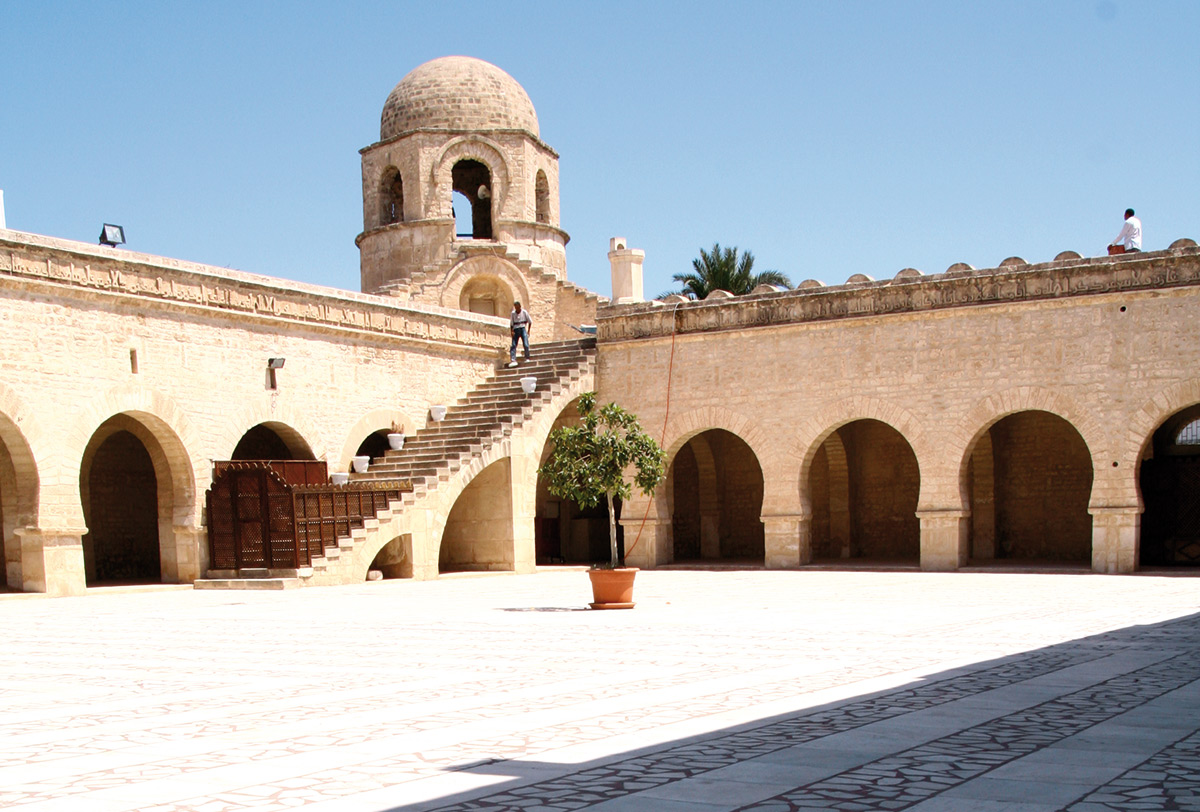Walls with battlements, watchtowers, fortresses, Great Mosque… An exceptional collection of austerely beautiful monuments, powerfully evocative of this medieval stronghold’s past.

Dominated by a high tower the colour of parchment, enclosed within mighty walls with battlements, the medina of Sousse tumbles towards the sea in a gentle slope.
A striking scene which inspired the French writer Maupassant with this vision: “But I’ve already seen this city! Yes, yes. I saw this brilliant vision another time in my young life, at school, when I was learning the history of the crusades in Burette’s History of France. (...) Oh! those walls, they’re the ones you see in the picture books, so clean and so regular you’d think they were cut from card…”
Heir to a great historical city known as Hadrumete, Islamic Sousse was first a small outpost of Kairouan, the first capital of the Maghreb.
In the 8th century, as it happens, a ribat was placed there, a community of ascetics dedicated to keeping watch over the coastline as well as the spread of religious doctrine. For the young Aghlabid emirate faced two dangers: the maritime might of the Byzantines and the emergence of subversive doctrines.
To house their community and to protect the population that joined them little by little, these men of faith had a small fort equipped with a high watchtower. This is the building that is known today as the Ribat. A place of study and contemplation, it was also a key location in the development of mystic Islam.
This Ribat has been preserved intact.
Erected facing the sea, it is highly similar to the small eastern castles which were being built in the same period in Syria: an enclosure flanked by round towers, a square courtyard surrounded by cells for provisions and for travellers passing through; and on the upper floor, the cells for the ascetics and a hall of prayer. The latter, strikingly sober, is the oldest in Africa that remains in its original form.
As for the watchtower, this tall cylindrical tower similar to the Abbasid minarets, made it possible to communicate using light signals with the long chain of ribats that were found all along the African coast. Thanks to them, according to historical records, a message could be sent from Alexandria to Ceuta in a single night.
It was the starting point for the conquest of Sicily expedition, then others heading for Italy and the neighbouring islands. The most noticeable elements of today’s medina date from this period: the ramparts, the Khalef tower and the Great Mosque.
The ramparts, remarkably well preserved, were built entirely from dressed stone.
The Khalef tower, resembling a Roman lighthouse and built upon a hill, took the lead from the Ribat watchtower, towering 50 metres above it. Integrated into a fortress, the Kasbah, built in the following centuries, it dominates the whole medina. Recently, the superb archaeological museum of the city was moved beneath its courtyard.
As for the Great Mosque, it has a surprisingly military appearance. Neighbour to the arsenal, it was a veritable fortress as well as a place of worship with its crenellated walls, its large corner towers that could accommodate war machines. One of these, topped with a dome, served as a minaret – as the mosque is devoid of them.
Inside, again the austerity is striking. The hall of prayer, all in dressed stone, is of a great simplicity, punctuated by short but massive pillars holding up large horseshoe arches.
One of the characteristic decorative elements of this period is the juxtaposition of multiple niches, sometimes accompanied by rosettes or emphasised using concentric arches.
One such element can be found in the Great Mosque of Sousse, decorating the mihrab (niche indicating the direction of prayer), as well as on the facades of several buildings such as the Sidi Ali Ammar mosque and the Kubba Bin Al-K’haoui dome.
Here and there, across the medina, can be found other pieces of architecture dating back to the early Middle Ages: mosques, house facades… But even with the newer buildings – mausoleum, tribunal, minarets – the simplicity of the carved decorative elements that highlight the beauty of the stone, sometimes emphasised with a ceramic frieze or a checkerboard pattern, has a striking effect. An exceptional collection of austerely beautiful monuments, powerfully evocative of this medieval stronghold’s past.
One of Sousse’s most peculiar monuments is the Kubba Bin Al-K’haoui, an enormous dome covered with zigzag furrows. It is the dome of a former hammam dating from the 11th-12th century. Its facade adorned with decorative niches is typical of Fatimid-Zirid architecture. The building was turned into a café in the Ottoman era.
The Ribat is a square fortress about forty metres across, built towards the end of the 8th century, equipped with many defensive facilities: watchtower, merlons, murder-holes overlooking the entranceway, arrow-slits built into the wall of the hall of prayer… Its architecture is similar to eastern examples.
The medina has preserved its traditional layout of winding alleyways and narrow dead ends. Dominated by the Kasbah and the Khalef tower, featuring ramparts and robust, austere monuments, it is representative of the military and religious architecture of the first centuries of Islam in Tunisia.
Entirely constructed from dressed stone, the walls of Sousse differ from the raw brick walls of Kairouan and Tunis from the same period. Certain sections are reinforced by two rows of superimposed vaults which increase their elasticity and resistance; a technique already used by the Punics.

With a hall of prayer wider than it is deep, simply punctuated by regular arcades and adjoining a large rectangular courtyard, the Great Mosque of Sousse is an example of the prototype which would spread and be constructed across the whole Islamic West. This hall dating from the 9th century was enlarged in the 11th century.
The courtyard is fringed on three sides by a portico bearing a long Kufic inscription. The robust appearance of the architecture is explained by the proximity to the sea, the source of danger.
© G. Mansour, “Tunisie, patrimoine universel”, Dad Editions, 2016
The medina of Sousse was declared a UNESCO World Heritage Site.
More about the World Heritage Sites in Tunisia